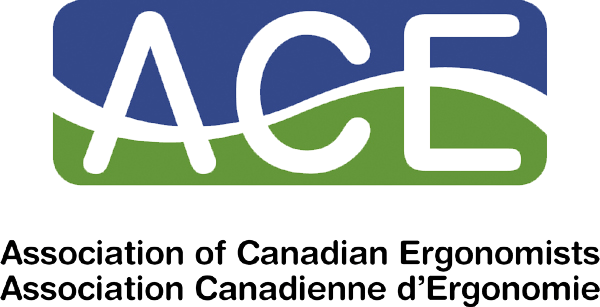Resources
Ergonomics Standards and Resources -
Click on this paper to view Ergonomics Standards, Resources, and How to participate in a Technical Committee. This information was collected for ACE by Lucy Hart of ergoCentric and Dan Robinson of Robinson Ergonomics as of June 23, 2020.
Ergonomics Standards and Resources
Ergonomic or Ergonomics Article -
Learn the difference in meaning between “ergonomic” and “ergonomics” and how to capture both for search engines for your company website (2019)
Ergonomic or Ergonomics Article
CRE-MSD – MSD Prevention Guideline -
The Centre of Research Expertise for Musculoskeletal Disorders (CRE-MSD) has developed a new prevention guideline for the province launched October 2019. The MSD Prevention Guideline is divided into three sections:
- Quick Start guideline for small and micro businesses
- Basic guideline for medium-sized organizations
- Comprehensive guideline for large organizations
All three guidelines are available at www.msdprevention.com
The website includes an introductory video, newly developed hazard identification and control approaches, graphics and downloadable templates and documents. Get resources to control workplace hazards. The new musculoskeletal disorder (MSD) Prevention Guideline has a user-friendly website tool that helps identify controls for workplace hazards.
Position Papers:
Hazards & controls picker Prevention guideline
Do sit-stand workstations improve cardiovascular health?
· Aging and MSD: Strategies for older workers
· Factors affecting operator exposure to whole-body vibration
· Fitting ergonomics to the engineers
· Glove selection to minimize effort and MSD risk
· How do we measure neuromuscular fatigue at the workplace?
· MSD prevention for the paramedic sector
· Observation-based posture assessment practices
· The use of stability balls in the workplace in place of the standard office chair
· There is no such thing as “non-specific back pain”
· Whole-body vibration: Overview of standards used to determine health risks
An Open Letter to the BC Government in Support of Permanent Standard Time -
Local and national governments around the world are considering proposals to eliminate the time change in favour of permanent Daylight-Saving Time (DST) or Standard Time. Earlier this year, the BC government invited the public to share their views in a poll but provided no option to vote for permanent Standard Time. Yet, experts in biological rhythms and sleep unanimously agree that Standard Time year-round is the best option for public health and safety (see attached position papers from various biological rhythms societies as well as a list of references to scientific articles).
Support of Permanent Standard Time
SRBR POSITION PAPER -
Less than 200 years ago, humans organized their daily routines by the sun clock (set by the rotation of Earth), which was in synchrony with their body clock (set by our individual biological clock). Now, most of us live in cities, work mostly in buildings,use electric light at night, and organize our daily lives by a social clock (set by human societies) that
is rarely in synch with the sun clock or the body clock. These new conditions challenge our health
and can cause safety problems; these challenges become even worse under Daylight Saving
Time (DST). In this article, we describe how the 3 clocks came to drift apart and how that can create problems.
Why we should abolish daylight saving time
Guideline for the Preparation of Ergonomics Reports (Physical Ergonomics) (2018) -
This document was originally prepared by the Ontario Region of the Association of Canadian Ergonomists/Association canadienne d’ergonomie (ACE). It was meant to be one of a series of Professional Practice Guidelines to be produced by ACE. It was updated in 2018 by Drs Village and Black.
This document has been prepared to provide professional guidance for the preparation and writing of reports based on physical ergonomics analysis.
Professional Practice Guidelines
MSD Code Mapping Article -
Until recently, compensation and OHS enforcement jurisdictions across Canada have been describing or defining work related Musculoskeletal Disorders differently from one another based on their different uses of the coding system that workers’ compensation Boards and Commissions in Canada use to classify injuries. This article describes how a more consistent MSD code mapping can be uses by researchers, OHS enforcement groups and any other parties interested in using coding information to identify MSDs across Canada. (2018)
